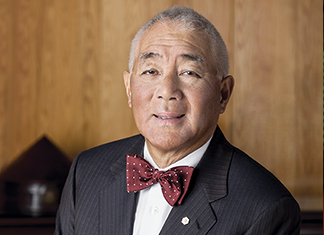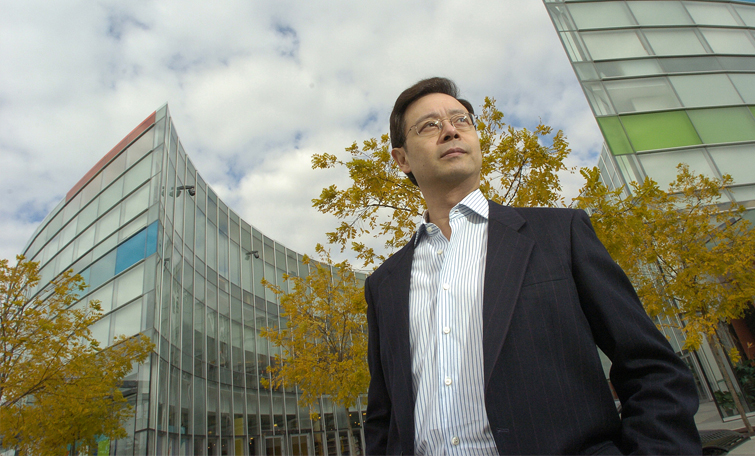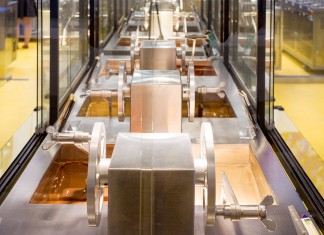Canada LNG: Bonanza or bust ?
- Caifu Magazine | by Caifu Global
- EN
By Alan Forsythe

Roughly twenty LNG projects are or have been in recent years proposed for Canada’s west coast. How many of these proposals will become reality, up and running, profit making ventures, nine? Four? Two even? Currently only one project is looking at beginning operations before the end of this decade, Woodfibre LNG. A modest project (compared to other proposals) located on Howe Sound less than an hour north of Vancouver. Woodfibre will be the first built from scratch LNG project primarily focused on the Asian export market as opposed to domestic or U.S export.
“Being first out of the gate has its advantages,” said Woodfibre LNG president, Anthony Gelotti. “[Obviously] you always want your facility to align with supply and demand. If you’re a big project you want 60-70 percent under long-term agreement, for some of those larger projects that amounts to six to seven tons to place in the market. Us, we’re 2.1 tons, so we’re talking to buyers in Asia for 1-1.5 million tons we can put into the market.”
Gelotti said most of the larger proposals were looking at a window of 2017 -2019 but are now pushing their completion dates out to 2021 or 2022. By then increased energy demand is expected to take up the slack in current North American oversupply.
However even that situation may be optimistic with the $36 billion Petronas led Pacific Northwest LNG approved (provincially, with federal approval expected) but no word yet if that project, which had been expected to break ground September 2015, will move forward, if at all.
Why the sudden decline in west coast LNG projects that current premier Christy Clark at one time promised would be a trillion dollar bonanza for the province (true it was an election year).
Largely it’s a matter of oversupply as Gelotti says (as do many others) the big growth markets for energy resources are now China and India. Even the traditional Asian markets, Japan, South Korea and Taiwan are seeing little to no growth in LNG demand.
“Russia has huge downstream volume they’re number one in proven and possible reserves, Iran and the rest of the Middle East is up there with them. So they’ve been able to get a lot of gas into the European market and elsewhere. One thing that’s changing that picture is U.S shale gas, which along with Canada puts North American reserves way up,” said Gelotti.
Many perceive the decline in natural gas prices as linked to the fall in crude oil prices. Furthermore the margin in the price for natural gas at Henry Hub (which sets the price for North American natural gas) and Asian markets is growing smaller. Henry Hub prices have been at about $3 (per million BTU) for the past year (compared to a high of over $12 in 2008). The Asian market typically prices natural gas at $12 -$16 but that price is expected to settle around $6-$8 as more LNG projects come online.
“You have to look at the value chain of gas,” said Gelotti. “It’s basic supply and demand, market fundamentals –how easy is it to get to market? [For example] there is now a lot of natural gas from unconventional sources in the U.S northeast, traditionally the gulf coast, Texas, Louisiana all of that gas was going to the U.S northeast via long haul pipelines. So say you’re transporting gas from Louisiana, right in the production zone, with a lot of liquidity. Now you have to transport it to the northeast in winter when demand is high, but the pipeline is full. So you get back to the difference between Henry Hub and the transport cost, which can be dollars, not cents. Now with northeastern shale they’re pushing gas south, and gas from the gulf has to go someplace else. And you lower the price until you find a buyer, and as long as North America has an oversupply the price will remain low.
“In Canada we have gas going to the U.S, where their demand is mostly met domestically, so you have to lower the price to find a market,” said Gelotti.
Clearly there’s no room to lower prices to find a market in North America, and with Europe heavily supplied with natural gas from Russia and the Middle East that leaves Asia.
“So looking at India and China, India is a little too far to export North American LNG. China as we know has entered into agreements with Russia, but China is a very large country and Russian pipelines are coming from the west, yet most of their population and almost all of the Chinese demand are on their coast. That is one reason they are building so many LNG receiving plants on their coast. A West coast LNG consultant, who asked not to be named, was a little more to the point on potential Russian competition for the Chinese market.
“Sure Russia has a deal to sell China gas on a pipeline that’s not built yet. Not to mention there’s a little thing called the Altai Mountains in the way, plus the upstream supply are mostly immature gas fields, and do you really want to rely on Russia for gas, maybe ask the Ukraine about that.”
The slow pace of west coast LNG development can also be explained by the Australian experience, where the rush to exploit natural gas on the Asian market led to cost overruns and labour shortages.
It was also almost always a given that of the 20 or so LNG proposals that have been announced in the past seven years easily 50 percent of them were unlikely to get past the proposal stage. But for the remainder do the economics of exporting west coast LNG still make sense, as Australia continues to aggressively develop their fields?
For his part Gelotti explains the economics of the Woodfibre project are very transparent and he remains unconcerned at the downturn in commodity prices. “When we talk to someone in Asia, we can say we’re not developing infrastructure, we’re not a fully integrated vertical company like some of the larger ones. “What we do we go into the market and buy storage and transport capacity. So you can look at AECO, the liquid index reported price, which is a true representation of costs. It can’t be manipulated; we’ll be bringing gas into the market at the published point – that’s the market. The next cost for us is getting gas to Station 2 and bringing it down the Fortis (Fortis is former government owned utility B.C Gas) pipeline so you go online to SPECTRA and get transport costs of getting itthere and down the Fortis line that’s price certainty.
“The next piece in the middle is liquefaction, for which we build in a reasonable return on investment, and then next step on the value chain is shipping, so again you talk to shipping brokers, everyday transport costs are published. Those are the costs to market, you can’t hide anything, on the larger projects the question is how much of their own infrastructure are they building? In short the current pricing is more a challenge than a concern. Can we invest and expect a reasonable return, yes. Projects that are on thinner economic ground, the answer is still probably yes.”
David Keane, president of LNG Alliance (an industry advocacy group) who has over 30 years experience in the oil and gas industry, is also optimistic about long term prospects for west coast LNG.
“I don’t think we’re too late at all, we haven’t missed the boat. LNG Alliance formed last year with four of the major LNG project proponents and added three more by the end of the year, including Exxon.”
He notes that while it might seem that some projects have been overly drawn out all seven of the proposed projects in his group are moving ahead.
“They all have their own timeline, and it’s not tied to a political timeline. There are a lot of moving parts involved that have to come together, not the least of which is markets lining up.”
The seven projects under the BC LNG Alliance umbrella are: Woodfibre LNG (2.1 millions tons per year), Kitimat LNG (10 million tons per year), Prince Rupert LNG (21.5 million tons per year), LNG Canada (24 million tons per year), Triton LNG (2.3 million tons per year), WCC LNG (30 million tons per year) Pacific Northwest LNG (19.7 million tons per year). He speculates that of the seven projects the aforementioned Pacific Northwest LNG is closest to moving ahead.
“I think they’re in a position to declare an investment decision.” Keane notes that once an investment decision is made on an individual project it moves forward. “At that point that’s it, it’s going ahead, shovels in the ground the next day.”
Sourcing buyers downstream for 19.7 millions tons a year of LNG can be, as Gelotti noted, a bit of a challenge. However despite his view that India is too far afield for west coast gas Pacific Northwest LNG has contracted 1.2 million tons a year downstream with India’s state oil company. Still that leaves another four to five million tons a year to place under long-term contract for the project to make economic sense. Keane though remains bullish on China’s capacity to absorb a lot of B.C’s energy exports.
“Long-term Asia will continue to grow, at, I expect, about 2 percent a year, most of that growth will be in China.”He echoes Gelotti somewhat and said that the price of oil will not affect long-term investment decisions in LNG.“I think the demand will be there and it won’t be based on the price of crude. These projects have an economic lifespan of at least 20-25 years but they will continue to operate beyond their economic lifespan, for as long as 60-70 years.”
Not all west coast LNG is being built from scratch. Fortis BC’s Tilbury LNG, a small LNG liquefaction plant in Delta (a suburb of Vancouver) has been operating since 1971 supplying liquid natural gas to various transportation systems (buses, commercial shipping).
They too are trying to grab a piece of the LNG market and have started construction on a $400 million expansion of their operation. Although largely for domestic use, they are pursuing a small export strategy, selling LNG to the U.S market, but across the Pacific to Hawaii not down the pipeline to continental U.S. They have a 15-year deal with Hawaiian Electric Co. and many see it as a small example of the potential for shipping B.C LNG.
Hawaii sees natural gas as a bridge energy between coal and solar, wind and other renewables. But natural gas may prove to be more than just a bridge energy. As former University of Victoria professor and climatologist Andrew Weaver showed in a 2012 study, natural gas is far less damaging to the environment and a much cleaner burning fuel than coal.
As air quality in Beijing deteriorates perhaps China’s demand for natural gas will increase as coal fired plants are closed? That’s speculation and if any of the LNG proponents in B.C have factored that possibility into their export equation they haven’t said.
What we do know is that the LNG industry represents a huge capital investment in the province of B.C. “Just one of the $12-$15 billion projects on the table will be the largest single investment in B.C,” said Keane. That perspective helps explain the nearly decade long process of bringing a LNG plant from proposal to completion, “with all projects it can take up to three years before making an investment decision,” he said.
In that time there is a great deal of consulting that takes place. Site consulting with engineers, but mostly with all three levels of government (local, provincial and federal) as well as with First Nations (Canada’s aboriginal community), “Hundreds of millions of dollars are spent before shovels break ground,” said Keane.
The main hurdles in the government bureaucracy are provincial and federal environmental certificates, as well as an NEB (National Energy Board) export license. Ten projects to date have export licenses, including all of the seven mentioned above. Most have environmental approval or environmental approval is (likely) pending.
“Yes the approvals process has been a long path,” said Gelotti, “but necessary, which in the end, in our view has proven to be a wise choice. It required a lot of due diligence and a lot of consultation but in hindsight it was worth it.”
The other hurdle is the grey area of First Nations consultation. Legally there is very little First Nations bands can do to prevent a LNG project from proceeding, but likewise it is considered unlikely that a project will proceed without First Nations approval.
“Our consultations with First Nations has been very positive,” said Keane. “This industry is a tremendous opportunity [for the province] and First Nations are an integral part of it. I don’t see First Nations as a challenge, and despite what some people have been saying we will see resolution [of their concerns] through consultation.”
One example of opportunities for First Nations is Douglas Channel LNG (1.8 million tons a year), it is a LNG cooperative owned by the Haisla Nation and other partners. As well it is expected First Nations will make up a significant portion of the labour pool. And if the LNG industry becomes as large as LNG Alliance envisions finding labour may become a crucial problem. Ironically Alberta’s woes may help solve a B.C labour problem.
“The decrease in oil frees up a lot of labour in Alberta, many who were commuting from B.C (two weeks on, one week off) or they will come to B.C from other parts of the country instead of going to Alberta,” said Keane. How big a labour pool is needed? Keane says 4000 construction jobs for LNG plants and up to 3000 construction jobs for new pipeline infrastructure. “The industry has recognized from day one that sourcing labour was a big part of any project. We don’t want a repeat of Australia where labour costs ballooned.”
The provincial government of B.C is already tracking and providing data on trades people and construction workers available, as well as how many are currently in apprenticeship programs.
“Peter Dyball of Pit Crew Consulting (a labour management company) who has been very, very involved in the Australian experience, and who is now involved here tells us that B.C is about three years ahead of where Australia was at a similar point in the industry’s development,” said Keane.
Further jobs will be created in the production of new gas fields. Most of the projects listed will be looking at Montney Basin and Horn River formations in Northeast B.C for their natural gas source.
Despite that Keane says the burgeoning LNG industry in B.C will be a huge positive not just for the province but also for Western Canada as a whole, calling it Nation Building. “The premier has said the net effect (or multiplier) ofLNG will be 100 thousand jobs, I don’t disagree.”















